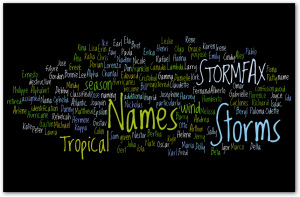In 2005, the name Katrina got a new reputation. After ravaging the southern United States, most notably the city of New Orleans, the deadly hurricane bearing that title became the most costly natural disaster in the history of the United States and forever changed a once whimsical name. Prior to being associated with complete destruction and devastation, the name Katrina was actually ranked among the top 300 names for baby girls. By 2007, the name had plummeted to number 600 on the list and, according to the Social Security Administration, as of 2009 it sat at number 815.
Because Katrina is a beautiful name, it’s somewhat disappointing that it will forever be attached to such a horrible disaster. But why Katrina? Why Andrew? Why Rita? How do any of these storms get their names? Do meteorologists sit around thinking of people they’d like to spite? Not really. Believe it or not, there’s actually a very organized system that is followed.
The process of giving names to storms has evolved many times over the course of history. At first, they were named after Catholic saints. Then, during World War II, military meteorologists began assigning female names to the disturbances, and in the 1950s the World Meteorological Organization (WMO) adopted the method for itself. Finally, in 1979, the WMO added male names as well as French and Spanish names to the roster in order to reflect the languages of the nations affected by the storms.
Today, the WMO cycles through 126 names separated into six lists—one list per year for six years— before it starts over. Each of the lists has 21 available names that can be used, and if a single season should see more than that, the remaining storms are named according to the Greek alphabet.
Sound confusing? It is! But that’s why we have meteorologists—and online searches. If you want to know the names on each list and find out whether or not yours will be making headlines in the future, visit the website of the National Hurricane Center at www.nhc.noaa.gov. There you’ll find the up coming names for storms occurring from now through 2017.
While we in the Midwest aren’t always affected by the physical destruction of hurricanes, as one nation, we all feel their impact in an emotional way. And for those whose names have been permanently tied to the natural disasters, we certainly offer our sympathy.
This spring, we at Midwest Storm Restoration encourage you to be safe and keep an eye on the weather. Should a disaster of any name strike your home, know that we’ll be here to help you pick up the pieces and put your property—and your life—back in place.

